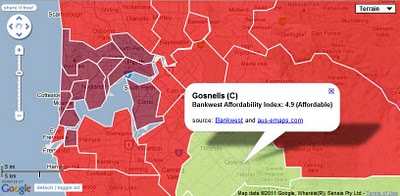Bankwest has just released a report on housing affordability in WA. Bankwest’s affordability index is a ratio of average house price in a Local Government Area to average worker’s salary. Index values are ranging from 0.9 for Mount Magnet to 49.9 for Peppermint Grove (5 is the upper limit of what is considered “affordable”). The information has been presented in WA Today as an alphabetical list of LGAs with corresponding index value. The paper concluded that workers (defined as a group consisting of police officers, nurses, emergency workers and teachers) “…need to move to Perth’s extremities – or even out of it” to find affordable housing.
This is a good example where information could be presented in a more visually attractive and more informative way – using maps! I have converted Bankwest index table to a thematic map to illustrate how this information could be presented to highlight regions which are still considered affordable.
The key to creating an informative thematic map is to pick the right method for dividing values to be mapped into meaningful categories that convey a certain message. In this case, the story is about locations which are considered affordable. The bank has already defined affordability cut-off value as 5 so that information should be preserved and conveyed on the map. There are many statistical approaches to decide on the split of data to create meaningful categories but on this occasion a simple “rule of thumb” approach is sufficient.
There could be just 2 categories – affordable and non affordable – to convey the message adequately. However, since two-colour map would be quite boring, we could also try to highlight “tail ends” of the data, that is cheap housing areas (eg. those with index value of 2 and below) and those totally out of reach (with index value of 10 and over). The values picked to define the two additional ranges are totally subjective but it does not detract from the key message – that is, which locations have affordable housing.
The selection of colours to present the information on the map is also important. I opted here for a combination to convey the message that there are two categories (affordable and non affordable) but also to indicate grading of index values from “low” to “high”.
Concluding, my appeal is, whenever you think about releasing information relating to postcodes, suburb or other spatially defined regions, please consider putting it also on an interactive map to create a bigger impact! And use my free reference map to enable easy sharing of the information for even greater impact!
